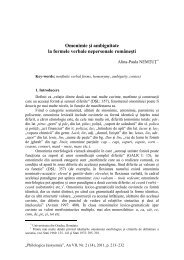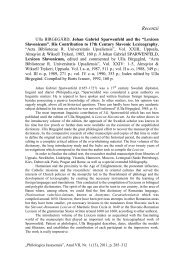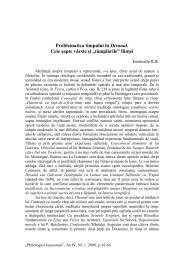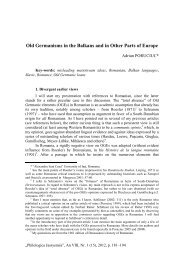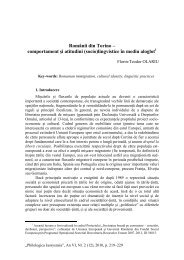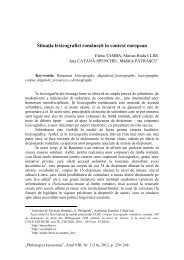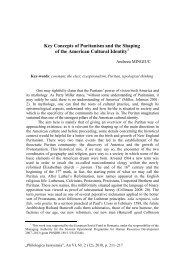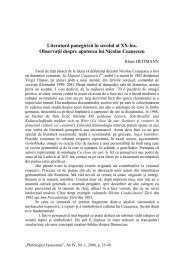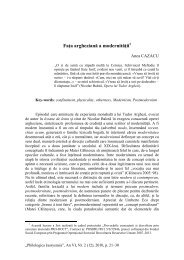Surrealism and The Feminine Element: André Breton's Nadja and ...
Surrealism and The Feminine Element: André Breton's Nadja and ...
Surrealism and The Feminine Element: André Breton's Nadja and ...
Create successful ePaper yourself
Turn your PDF publications into a flip-book with our unique Google optimized e-Paper software.
Ileana Alex<strong>and</strong>ra ORLICH<br />
_______________________________________________________________________________________________________________________________________________________________________________________________<br />
Such exalted praise of his “supreme love” leads to Breton’s mythic view of<br />
women expressed in his last prose narrative, Arcane 17 (1944), which asserts that<br />
women might serve as a means for humanity to attain spiritual enlightenment <strong>and</strong><br />
renewal.<br />
Naum must have read <strong>Nadja</strong> as a form of mental rewriting, in the fashion of<br />
Henry James’s famous theory that discusses his own looking at the creative problems<br />
the novel he is reading tried to solve (or express) <strong>and</strong> then imagining the ways in which<br />
he would have dealt with these problems within the same structure 9 . In similar ways, the<br />
construction of Zenobia must have been subconsciously drawn from what Ralph Waldo<br />
Emerson, in speaking of “the secret of the reader’s joy in literary genius <strong>and</strong> the contagious<br />
character of felicitous expression,” defined as “the mechanics of inspiration by which a<br />
text induces an independently creative state of mind in the reader, [<strong>and</strong> becomes] a<br />
mechanical help to the fancy <strong>and</strong> the imagination that trigger in the reader a desire to<br />
write” 10 .<br />
Published a little over a half century later than <strong>Nadja</strong>, Zenobia subscribes to<br />
Breton’s view of interchangeability of dream <strong>and</strong> reality <strong>and</strong> the interference of the<br />
conscious (rationality) <strong>and</strong> the unconscious or subconscious (an antithesis to reality) as<br />
two apparently contradictory states that will be resolved into a sort of absolute reality, of<br />
surreality.<br />
Both <strong>Nadja</strong> <strong>and</strong> Zenobia detail their author-narrator-protagonist pursuit of <strong>and</strong><br />
engagement with an ideal feminine counterpart to the masculine side to satisfy the<br />
Platonic idea of the original <strong>and</strong>rogynous couple, as expressed by Aristophanes in <strong>The</strong><br />
Symposium. Through catalytic love, this missing feminine part that will be recognized<br />
instantly will then dissolve in complete physical <strong>and</strong> spiritual sameness with the<br />
masculine side. Together they attain <strong>and</strong> nourish an extraordinary kind of perception<br />
that erodes <strong>and</strong> transcends the habitual experience of concrete reality opening up a fluid<br />
world of physical objects <strong>and</strong> imagination that will enable them to reach <strong>and</strong> experience<br />
a different, surreal realm. To implement such textual objectives, both authors use an<br />
abundance of signs, words, names, <strong>and</strong> free associations <strong>and</strong> fantasies of a poetic<br />
domain that cease to give routine directions in a familiar world, but create new affinities<br />
or assert their mystery.<br />
Zenobia, which proposes from the start an unlikely space of indeterminate<br />
temporal progression, begins with the narrator-protagonist’s visit at the house of Mr.<br />
Sima, a neighbor <strong>and</strong> friend (Sima is the French word amis spelled backwards) of the<br />
marsh-dwelling narrator. Here the dreamlike scenario alternating between magical<br />
reality <strong>and</strong> hallucination is further complicated when the narrator finds a very weird<br />
looking old man named Dragoş, who appears to be asleep on top of a table, <strong>and</strong> two<br />
young men, Jason <strong>and</strong> Peter, clustered around a beautiful, nameless girl. Wrapped in a<br />
dirty sheet of plastic, she had been found “almost unconscious” in the marsh by the two<br />
young men whose attitudes <strong>and</strong> behaviors toward her could not have been more<br />
different: Jason, who kicks her <strong>and</strong> calls her “scum,” <strong>and</strong> Peter, who claims to love the<br />
girl madly but appears strangely impotent in his affection. Smitten with the girl’s<br />
unimaginable beauty, the narrator, who calls himself by his real name, Naum, <strong>and</strong> who<br />
9 See James’s letter to Mrs. Humphrey Ward (July 26, 1899), “Letters”, Vol. 4, p. 111.<br />
10 Ralph Waldo Emerson, Uses of Great Men <strong>and</strong> Nominalist <strong>and</strong> Realist, respectively.<br />
216



